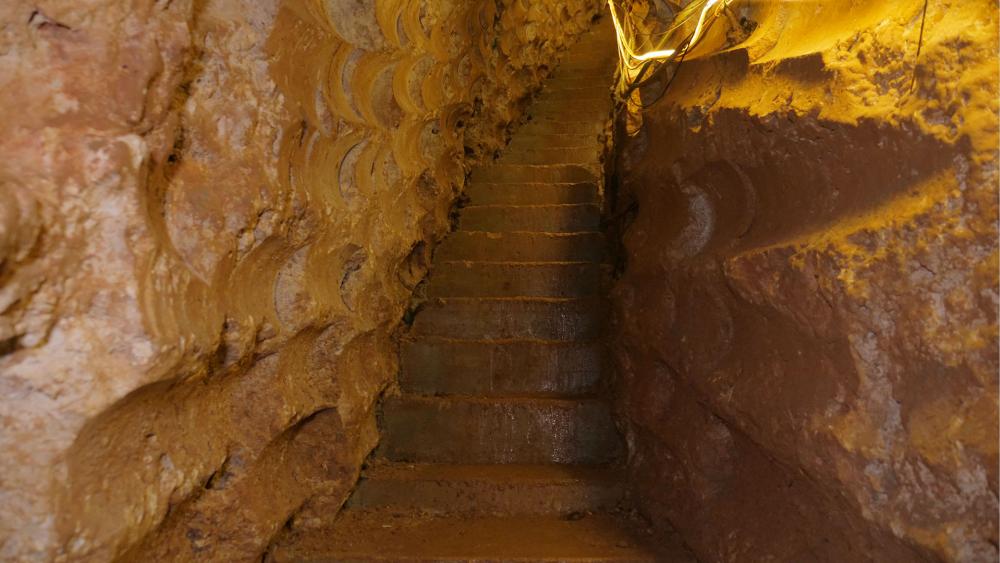Hezbollah's Secret Weapon Exposed: Israel Destroys Massive Iran-Backed Terror Tunnel
Zar’it is a small agricultural community of 250 residents on the Israel-Lebanon border. Above ground, it’s quiet and peaceful, but underground, Hezbollah was planning for death and destruction.
It’s well known that Iranian-backed Hezbollah terrorists in Lebanon have more than 120,000 missiles pointed at Israel. A less visible weapon with dangerous potential is a network of attack tunnels running underneath Israel’s northern border.
Israel recently exposed one of the most significant tunnels to date and took CBN News for a rare look inside, where we stood just feet from the Lebanese border.

The tunnel is called Ramyeh, named after the Lebanese village where the tunnel began. It was also the most difficult for the Israel Defense Forces (IDF) to discover. It's the longest also and the deepest -- the equivalent of a 22-story building built underground.
“You can see the winch here on the wall. Over there, there’s electricity, communications lighting and there’s a phone that was actually connected for the first day when we exposed the tunnel,” said IDF spokesman Lt. Col. Jonathan Conricus.
 “The wire was still live. One of our guys jokingly picked it up and asked for anybody to answer on the other side. There was no answer but it was live and then they disconnected it,” Conricus explained inside the tunnel.
“The wire was still live. One of our guys jokingly picked it up and asked for anybody to answer on the other side. There was no answer but it was live and then they disconnected it,” Conricus explained inside the tunnel.
All the workmanship is Hezbollah’s, including steps carved in the stone. It took years to build and millions of dollars to construct, much of supplied by Iran.
 “You can see the remains of a rail system that Hezbollah had in place, which is what they used in order to bring equipment up basically, and also to take all of the debris and rocks and shift it out of the tunnel,” Conricus said.
“You can see the remains of a rail system that Hezbollah had in place, which is what they used in order to bring equipment up basically, and also to take all of the debris and rocks and shift it out of the tunnel,” Conricus said.
“This would attach to an electric drill, power drill that would drill like this and once it got to the end of the cup itself, they would just pull it out, knock the piece of rock off and then shift that piece of rock back,” he said.
The size of the tunnel is impressive. Hundreds of Hezbollah commandos could have come into Israeli towns to kill and kidnap.
 “As you can see behind me is the last and the highest point this Hezbollah tunnel got. As you can see, it’s only a few meters from ground level,” Conricus said standing outside the entrance Israel made into the tunnel.
“As you can see behind me is the last and the highest point this Hezbollah tunnel got. As you can see, it’s only a few meters from ground level,” Conricus said standing outside the entrance Israel made into the tunnel.
Conricus told CBN News the tunnel is almost a mile long and was nearly operational.
“Operational in the sense that Hezbollah (was) having the ability to break out and then to run to the nearest Israeli community,” Conricus said. “There are two communities here nearby, less than six minutes running distance from where we are now.”
Tunnel warfare expert Daphne Richemond Barak says the value of this type of warfare is priceless for Hezbollah.
“It acts as an equalizer between them and the enemy, which is very powerful in terms of intelligence, reconnaissance, and civilians, almost virtually endless capabilities so this is something that goes on underground away from sight,” Barak told CBN News.
 Barak, author of Underground Warfare, said this warfare can’t be seen and it’s very costly for the enemy to detect even if they suspect something is going on.
Barak, author of Underground Warfare, said this warfare can’t be seen and it’s very costly for the enemy to detect even if they suspect something is going on.
“The potential reward is a major one if only it succeeds because it neutralizes the technological advantage of the Israeli army,” Barak said.
For now, Conricus said the IDF believes it has found and rendered all the border tunnels useless, either by blowing them up or filling them with cement.
“That doesn’t mean for even one second we have let down our guard and have stopped looking,” Conricus added.
In the meantime, this massive tunnel represents the persistent determination of Hezbollah to destroy Israel and the IDF’s vigilance to stop one of Israel’s greatest enemies.




